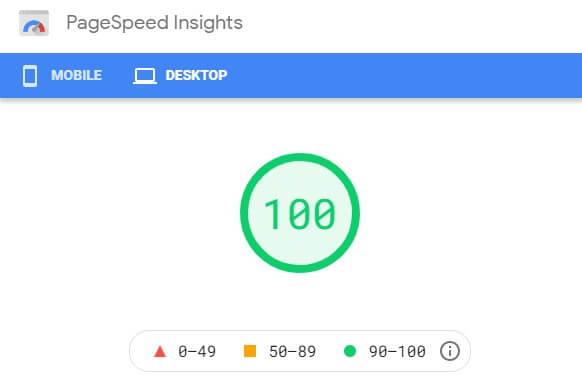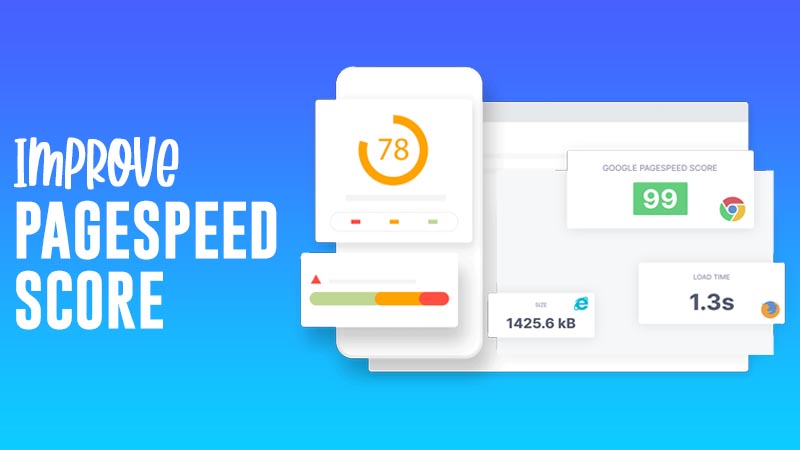Google has a complex algorithm that takes a lot of factors into consideration before indexing and ranking a webpage. One of these ranking factors is page speed.
Optimized pages that load faster perform better in Google search results.
This is why webmasters spend a lot of time obsessing about page speed…..and why won’t they?
Your page speed is crucial to provide a better user experience and improve SERPs ranking.
Even if you have great content, people will ignore it if you can’t make your page load faster. There is no point in writing a winning article if it takes ages for your website to load. How your audience interacts with your website depends on your page speed.
Slow websites usually have a higher bounce rate which directly affects their ranking let alone their business. Page speed is essential if you want to improve your conversion rate and optimize your website for search engines.
In this day and age of the Internet, human attention span has decreased from 12 to 8 seconds. Users don’t like to wait too long to find answers to their search queries.
Google always prioritizes user experience over anything else. So if you are unable to provide a better user experience, you won’t likely see any organic traffic coming your way.
To help webmasters analyze and improve their site performance, Google has introduced the Google PageSpeed Insights tool.
Google PageSpeed Insight will help you analyze your webpage and provide suggestions accordingly to make your webpage load faster.
It shows reports of how your website is performing on both desktop and mobile devices and what changes you can make to provide a better user experience.
We will talk more about this tool but first, let’s understand what is page speed.
What Is Page Speed

Page Speed is referred to the amount of time that it takes for the content of a webpage to load. There are a lot of factors that determine the page speed of a website which include, your website’s architecture, backend scripts, server speed, server response time, your overall page size, and the number of images in your webpage.
But these are just a few elements that correlate with page speed. If you use any page speed analyzer tool you will see all the other components that influence the page speed of your website.
A lot of people often confuse the term “page speed” with “site speed”.
Site speed is measured from a random sample of your site’s page visits. Whereas there are multiple metrics to measure the page speed.
Here we have listed the most common metrics to measure page speed.
- Page Load Time: This is the amount of time that takes to fully render and load 100% of the content of your web page. It is used to determine how fast a page loads fully on both mobile and desktop devices.
- Time to first byte (TTFB): This is the time it takes after a request is submitted, for the server to transmit the first byte of data to the browser and the browser to display that data.
- First Contentful Paint (FCP): This is the time it takes for a browser to render the first piece of DOM content after a user navigates to your page.
Optimizing your page speed can be a bit tricky as there are multiple metrics that affect the loading time of your webpage.
To help you evaluate and improve your page speed, you can use Google PageSpeed Insight as it directly incorporates data from CrUX (Chrome User Experience Report).
Why Improving Page Speed Is Important

Google has stated multiple times that page speed is an important ranking signal among many. Its algorithm uses the page speed data from Google lighthouse and chrome user experience report (CrUX) to rank web pages.
Speeding up your website is vital as it will help you grow your organic search traffic and improve ranking. But most importantly, it will improve the user experience of your website. If you are working on SEO for your site, page speed is something that can’t be overlooked.
Working on your page speed and improving your loading time can be really beneficial as it will:
- Improve the ranking of your website
- Increase your content visibility
- Drive organic traffic to your site
- Decrease the bounce rate
- Increase your conversion rate
- Provide better user experience
- Generate more revenue
- Bring quality traffic to your website
If you have a website that takes ages to load not only you will lose revenue but you will also lose credibility.
Running a slow website is like the curse of Sisyphus. A slower web page is like a large stone that you will have to carry to the top of the hill.
There is no point in repeatedly climbing the “hill of content” with additional weight in your back.
Google PageSpeed Insights

If you are familiar with SEO, you probably have heard about Google PageSpeed Insight. It is a free tool from Google that lets website owners test their website’s performance.
You can type in any URL to see how fast that website loads. Google then gives the URL you tested a score out of 100 based on several page performance indicators and page speed metrics.
Google PageSpeed Insight will show you the areas where your website might need improvements and optimization.
It will also help you with recommendations and steps you can take to improve your site’s performance.
Google PageSpeed Insight uses data from Lighthouse which is an automated technology for enhancing the overall quality of web pages.
You can assess performance, accessibility, progressive web applications, and other characteristics using Google Lighthouse.
Perfecting Google PageSpeed Score

While content creators are busy perfecting their Google PageSpeed Insights score, they often overlook the most important part…optimizing pages.
Your main intent of using the Google PageSpeed Insights report should be following the recommendations not obsess over numbers.
Don’t get wind up in the number game. Rather focus on improving your overall site’s performance and providing a better user experience. These metrics sometimes don’t reflect how your website is performing in real-time.
Having said that, you should definitely look to improve the loading time of your site as much as possible. You don’t have to strive for the 100/100 page speed score.
When you work on the recommendations and you will eventually see changes in the score.
There are multiple platforms for checking the page speed of your website.
GTmetrics is another great tool that let you analyze your page speed from various location. It combines the results from Google PageSpeed Insights and Yslow to give you a broader report. There are also other page speed checking tools such as Pingdom that show all the areas your webpage needs to improve.
Each of those tools uses different metrics and you might see different results across these platforms. This shows how inconsistent these numbers may be.
Your website visitors don’t care about your Google PageSpeed Insights score nor do they care about how you optimize your site. They want a faster webpage and good content.
So instead of looking at those numbers, you should use the recommendations to improve your page speed and provide a better user experience.
The goal of using Google PageSpeed Insights is not to get a high score. Instead, it’s about identifying issues and areas your website can improve.
You can figure out where you need improvements and elements you need to optimize to reduce both actual and perceived loading times.
How To Improve Google PageSpeed Insights Score

Apart from the user experience and content of your website, how your site performs is also very important to Google.
As Google created a separate tool for website owners to analyze their website’s page speed and identify all the elements that are slowing down their website, it is obvious that Google wants your website to be fast. So it is understandable that your PageSpeed insights score might affect your SERPs ranking.
But that does not mean your website needs to have the perfect score in order to rank on top of search results. Google doesn’t just take the score inside that circle into consideration. There is more to that than just an arbitrary number.
After the Core Web Vitals algorithm update in May 2021, Google announced that page experience signal would be included in Google search ranking. It’s been over a decade since Google publically announced that page speed is an important ranking factor.
But now Google will also look into how users interact with a webpage. This means they will take into account your Time To First Byte (TTFB), First Contentful Paint (FCP), time spent on a page, bounce rate, and some other metrics when ranking a webpage.
While the numbers can give you an insight into how your website is performing, sometimes it doesn’t capture the whole picture.
So instead of focusing on perfecting your Google PageSpeed Insight score, you should rather aim to improve your overall SEO and how you can speed up your web pages.
Here we will share some recommendations that will help you identify elements cramming your web pages and what you can do to decrease the loading time of your web pages.
1. Avoid Multiple Page Redirects
Redirects happen when you point your page to another URL or delete a web page that is already indexed. There are also multiple page redirects that may happen when you are using a theme that is poorly optimized and not responsive for different devices.
Post-click landing page redirects can be really frustrating for users and they can slow down your page.
We are using a responsive theme for which our mobile users don’t have to go through multiple post-click landing page redirects.
Let’s take a look at how post-click landing page redirects might affect your page speed:
- example.com – This website uses responsive web design, therefore no redirects are needed thus it is the best and fastest option.
- example.com → m.example.com/home – This page goes through multiple redirects for mobile users. Thus it has a comparatively slower loading time.
- example.com → www.example.com → m.example.com – very slow mobile experience.
Sometimes redirects can be useful and there is nothing wrong with it, but they can cause a severe delay in your loading time.
Try to avoid many redirects and use a responsive theme that smoothly adjusts its layout based on the screen size and resolution.
2. Optimize Image To Increase Page Speed
Image optimization is a critical component of on-page SEO. It’s not enough to use the right image file name and an alt-tag for your photos; they also need to be compressed. Images may have a significant impact on page performance, slowing down your website.
Google has warned webmasters about how image size can affect page speed. Images can make your web page a little heavier, which makes it take a little longer to load. However, having an optimized image reduces the size of the website, allowing it to load faster.
You’ll need high-quality photos in the correct format, dimension, size, and resolution while reducing the file size to a minimum.
The size of your web page can have a direct impact on the loading time and Google PageSpeed Insights score and eventually affect your SERPs ranking.
Because images and other graphic elements account for 50-80% of the overall page size, compressing your images using the right format can help you drastically reduce loading time thus providing a better user experience.
3. Enable Gzip compression
Browser these days are capable of rendering an optimized and compressed version of a webpage. Instead of loading the whole web page, you can use GZIP compression to shrink your page up to 90% and serve an optimized version of your page.
GZIP compression is now used by nearly all web servers and browsers to compress and decompress web pages as they go back and forth across the internet.
This file compression method is most commonly used on text and codes, and it may shrink JavaScript, CSS, and HTML files by up to 90%. Instead of delivering the whole page to the user, the browser can request a compressed version that loads in a fraction of the time.
4. Minify CSS, HTML, JavaScript
Sometimes due to bad coding and optimization, our website gets bogged down with unnecessary lines of codes on the backend. As browsers must process all of these lines of codes, these needless codes slow down your page.
“Minifying” codes refer to removing unnecessary or redundant data without affecting the front-end of your website and how the page is processed by the browser. Sometimes you don’t need that extra line of code to properly run your website. By removing these unnecessary characters, spaces, and duplications, your page loads faster.
Google prefers webmasters to keep their codes optimized and minify the code on the backend of their website. You can use the AMP framework from Google to minify your backend files and get a stripped-down version of HTML, CSS, and JavaScript. This will help your web page load in a fraction of a second.
There are simple ways you can minify your CSS, HTML, and JavaScript codes without having any coding skills.
If you are a WordPress developer you can use a caching plugin like wp-rocket that lets you minify your codes.
5. Enable browser caching for your site
Before a page fully loads for a user, it may take many requests between the server and the browser. This may not be the most efficient way to serve content to your user as it can take some time.
This is where browser caching comes to play. Browser caching allows web browsers to rapidly provide a static version of your website to users instead of dynamically serving the content of your webpage every time someone clicks through. What Caching does is let the browser “remember” certain elements that have been recently loaded — header, navigation, logo, etc.
The more items a browser can cache, the fewer elements it has to load when a user requests anything, and the faster a page will appear.
When compared to a website without caching, serving a static version of your webpage takes relatively little time. This can improve your PageSpeed Insights score drastically.





